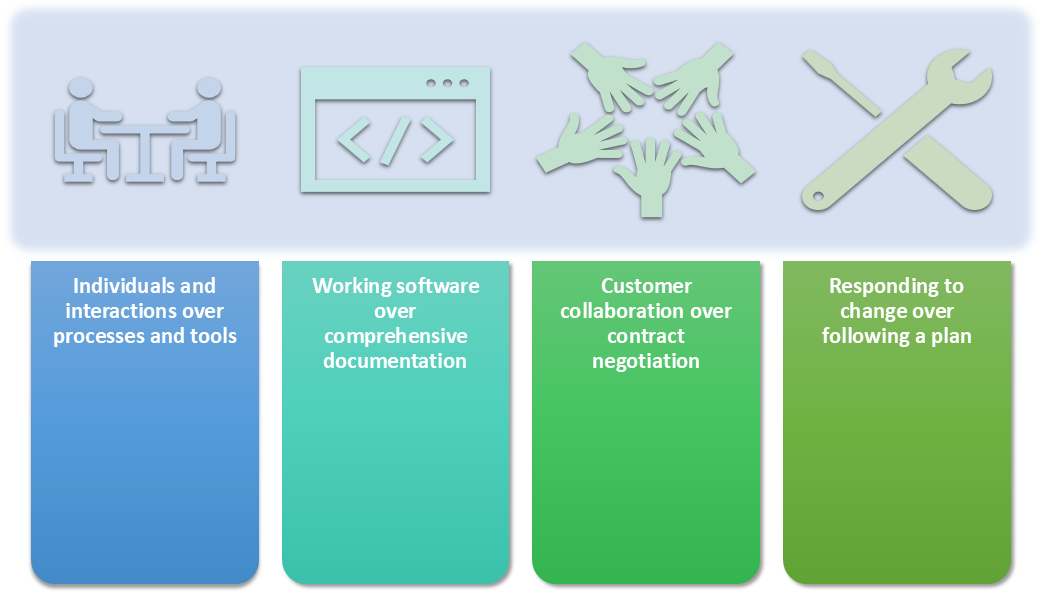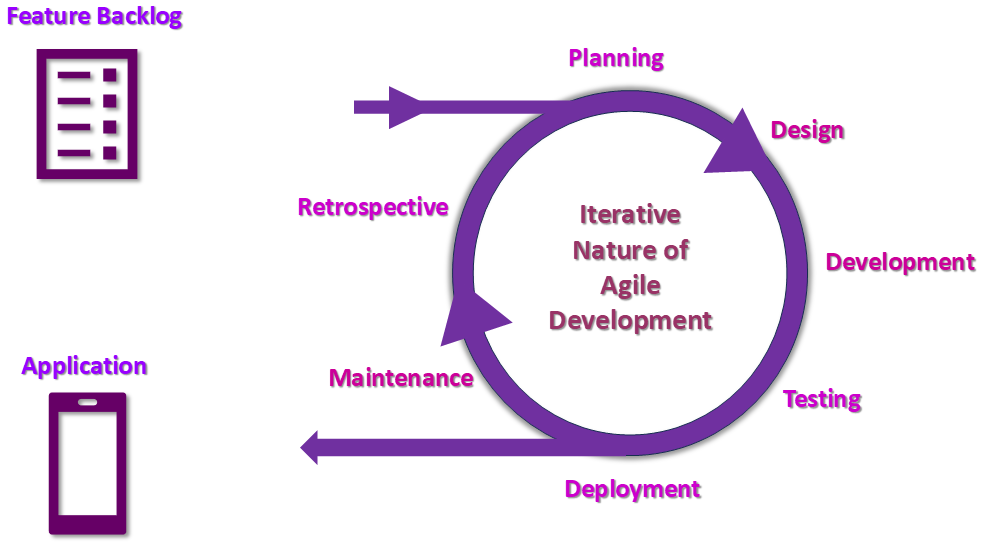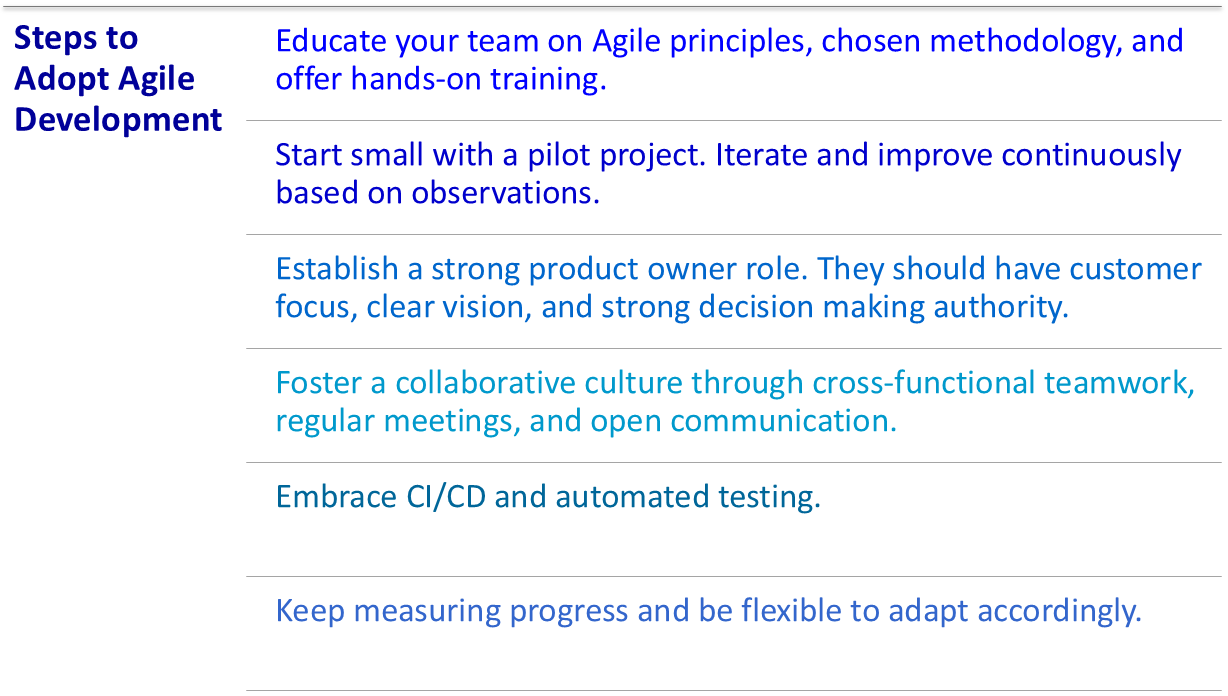Agile Development – A Complete Introduction
Is your software development process as dynamic as the tech world itself? If not, then it’s time to consider Agile Development.
Traditional development methodologies often struggle to keep up with technological advancements and evolving customer demands. Agile Development offers a refreshing alternative that emphasizes iterative development, collaboration, and customer satisfaction. By breaking down projects into smaller, manageable iterations, Agile teams can deliver high-quality software products quickly and effectively.
Let’s learn more about this methodology that revolutionized software development.
Agile Development History: From Waterfall to Agility
Before the advent of Agile, software development primarily followed a sequential, rigid approach known as the Waterfall model. In this model development phases like requirements gathering, design, implementation, testing and deployment were strictly linear. This approach often led to inflexible processes, delayed deliveries, and a lack of customer satisfaction.
In the late 1990s, a group of software development practitioners recognized the limitations of traditional methods and sought a more adaptive and customer-centric approach. By the late 1990s, practices like Extreme Programming (XP) and Scrum had begun to gain traction. These methods prioritized incremental releases, customer involvement, and team self-organization. The need to unify these new, flexible approaches gave rise to the Agile Manifesto in 2001.
The core values of the Manifesto are:

Today, Agile is recognized as a leading approach for creating flexible, high-quality software while continuously delivering value to customers.
Agile Development Lifecycle
Unlike traditional “waterfall” models, which use a linear, step-by-step approach, the Agile lifecycle is iterative and incremental. This means that development occurs in cycles, with each cycle delivering a potentially shippable product increment. This approach allows for continuous feedback, flexibility, and rapid adaptation to changing customer needs.

Here is an overview of the stages involved in Agile Development.
Concept/Initiation Phase
- Description: This is the initial stage where the project idea is conceived, business needs are identified, and feasibility is assessed.
- Key Activities:
- Understanding and defining the project goals and scope.
- Identifying key stakeholders, their needs, and expected outcomes.
- High-level planning and prioritization of project features or requirements (often leading to the creation of an initial product backlog).
- Output: A high-level project vision, stakeholder expectations, and a prioritized backlog of features or tasks.
Requirements Gathering and Planning Phase
- Description: During this stage, teams collaborate with stakeholders to break down and prioritize the requirements in detail.
- Key Activities:
- Collaboratively discussing user stories, features, and requirements with stakeholders (product owners, end-users, etc.).
- Creating and refining the product backlog, which is a prioritized list of work items for the team.
- Conducting release planning to define the overall timeline and sprints.
- Estimating effort for user stories, often using story points or other estimation methods.
- Output: A refined product backlog and an initial roadmap for project delivery.
Design Phase
- Description: The design stage focuses on outlining how the features and functionality will be implemented.
- Key Activities:
- Discussing and defining the technical architecture of the solution.
- Designing user interfaces and user experiences, often using wireframes, mockups, and prototypes.
- Conducting collaborative design sessions to ensure shared understanding across the team.
- Output: Design artifacts (e.g., architectural diagrams, wireframes) and a clear understanding of how the feature will be implemented.
Development Phase
- Description: In this stage, developers build the functionality as defined in the product backlog.
- Key Activities:
- Sprint Planning: At the beginning of each sprint (an iteration lasting 1-4 weeks), the team selects a set of high-priority items from the product backlog to work on.
- Coding: Developers write code to implement the features by adhering to agreed-upon coding standards and practices.
- Daily Stand-Up Meetings: Team members meet briefly each day to discuss progress, challenges, and next steps to ensure transparency and collaboration.
- Continuous Integration: New code is regularly integrated into a shared repository, and automated tests are often run to catch issues early.
- Output: A potentially shippable product increment (working software) that is reviewed at the end of the sprint.
Testing Phase
- Description: Agile emphasizes continuous testing throughout the lifecycle to ensure high-quality software and early detection of defects.
- Key Activities:
- Conducting various types of testing (unit tests, integration tests, system tests, acceptance tests, etc.).
- Test-Driven Development (TDD) and Behavior-Driven Development (BDD) practices are often used to write tests before coding or aligning development with business goals.
- Regression testing to ensure new changes do not negatively impact existing functionality.
- Output: Verified software with identified defects addressed which leads to higher confidence in the quality of the increment.
Deployment/Release Phase
- Description: Once a feature or increment is considered ready, it is released to the production environment or delivered to the customer.
- Key Activities:
- Deploying the increment to production (or a staging environment).
- Ensuring that the deployment process is automated where possible (using Continuous Delivery/Deployment practices).
- Performing any necessary final checks such as smoke tests, to confirm the software works as expected.
- Output: A working product increment available for customer use or feedback.
Review and Retrospective Phase
- Description: At the end of each sprint, the team conducts review and retrospective sessions to reflect on the work done and identify areas for improvement.
- Key Activities:
- Sprint Review: The team demonstrates the completed work to stakeholders for feedback. This session ensures alignment with customer needs and provides an opportunity to adjust priorities.
- Sprint Retrospective: The team reflects on their own processes by discussing what went well, what didn’t, and what can be improved in the next sprint.
- Output: Feedback and actionable insights to improve future work and enhance team performance.
Maintenance and Support Phase
- Description: After release, the software enters a maintenance phase where the team addresses issues, makes updates, and continues delivering enhancements.
- Key Activities:
- Fixing bugs and responding to user feedback.
- Making incremental improvements and adding new features based on changing requirements.
- Continuous monitoring and support to ensure the software performs as expected.
- Output: Ongoing updates and a high-quality, continuously evolving product.
Agile Development Key Practices
You will find these key practices at the heart of every Agile Development endeavor.
- Iterative Development: Breaking down development into smaller cycles to deliver working software frequently.
- Incremental Delivery: Continuously delivering value through small, incremental releases.
- Customer Collaboration: Involving customers throughout the development process to ensure their needs are met.
- Self-Organizing Teams: Empowering teams to make decisions and manage their work.
- Continuous Improvement: Regularly reflecting on the process and making adjustments to improve efficiency and effectiveness.
Agile Methodologies Types
Here are some of the popular Agile methodologies that are used:
Scrum
- Overview: Scrum is one of the most widely adopted Agile frameworks. It focuses on delivering products incrementally in short, time-boxed iterations called sprints (usually lasting 1-4 weeks). Scrum emphasizes collaboration, accountability, and continuous improvement through clearly defined roles, ceremonies, and artifacts.
- Key Components:
- Roles:
- Product Owner: Represents the customer’s interests, defines and prioritizes the product backlog, and ensures the team delivers value.
- Scrum Master: Facilitates the Scrum process, removes obstacles, and supports the team’s productivity.
- Development Team: A cross-functional group of professionals who build and deliver the product increment.
- Artifacts:
- Product Backlog: A prioritized list of features, enhancements, and tasks for the product.
- Sprint Backlog: The work to be done during a sprint, derived from the product backlog.
- Increment: A potentially shippable product version produced at the end of each sprint.
- Ceremonies:
- Sprint Planning: A meeting to select work items for the sprint.
- Daily Stand-Up (Daily Scrum): A short, daily meeting to review progress and obstacles.
- Sprint Review: A demonstration of completed work and collection of feedback.
- Sprint Retrospective: A meeting to reflect on the sprint and identify improvements.
- Roles:
- Best For: Projects that require flexibility, frequent feedback, and changing requirements.
Kanban
- Overview: Kanban focuses on visualizing the workflow and optimizing the flow of tasks to achieve continuous delivery. Unlike Scrum, Kanban does not prescribe specific roles or iterations. Instead, it allows teams to make incremental changes to their process.
- Key Components:
- Visual Board: Kanban uses a board to visualize work items, typically organized into columns (e.g., “To Do,” “In Progress,” “Done”) to track the status of each task.
- Work-In-Progress (WIP) Limits: Teams set limits on the number of work items allowed in a specific stage to avoid bottlenecks and overloading.
- Continuous Improvement: Teams regularly review and improve their processes to maximize efficiency.
- Best For: Teams looking for flexibility, continuous delivery, and a focus on improving flow and productivity.
Extreme Programming (XP)
- Overview: XP is an Agile framework that emphasizes technical excellence, continuous feedback, and customer satisfaction. It focuses heavily on engineering practices such as Test-Driven Development (TDD), frequent releases, and collaborative coding practices.
- Key Practices:
- Test-Driven Development (TDD): Writing tests before code to ensure that all functionality is thoroughly tested.
- Pair Programming: Two developers work together at one workstation to enhance code quality and collaboration.
- Continuous Integration: Code changes are integrated into a shared repository frequently, often several times a day.
- Refactoring: Continuously improving code without changing its behavior to maintain code quality.
- Best For: Projects where technical excellence, rapid feedback, and frequent releases are critical.
Lean Software Development
- Overview: Derived from Lean manufacturing principles, Lean Software Development focuses on delivering value to the customer, reducing waste and optimizing efficiency.
- Key Principles:
- Eliminate Waste: Identify and remove activities that do not add value to the customer.
- Build Quality In: Ensure quality at every stage of the development process.
- Deliver Fast: Minimize the time from idea to delivery.
- Respect People: Empower and engage the team to improve the process.
- Best For: Projects focused on efficiency, minimizing waste, and delivering maximum value with limited resources.
Crystal Family of Methodologies
- Overview: Crystal is a family of Agile methodologies tailored to different project sizes and criticalities (e.g., Crystal Clear for small teams, Crystal Red for larger teams). It emphasizes flexibility, collaboration, and simplicity by recognizing that every project is unique.
- Key Characteristics:
- People-centric: Focuses on individuals and interactions over processes and tools.
- Customizable: Encourages teams to adapt their processes to suit their specific needs.
- Lightweight: Minimal documentation and flexible processes.
- Best For: Projects that value flexibility and require a customized approach to suit team dynamics and project requirements.
Dynamic Systems Development Method (DSDM)
- Overview: DSDM is a comprehensive Agile framework focused on delivering business value quickly and consistently through an iterative, incremental approach. It emphasizes collaboration, quality, and active user involvement.
- Key Components:
- MoSCoW Prioritization: Requirements are categorized as Must Have, Should Have, Could Have, or Won’t Have to focus on delivering the most critical features.
- Time-Boxing: Work is divided into fixed time periods, ensuring consistent progress.
- User Involvement: Continuous engagement of end-users and stakeholders throughout the project.
- Best For: Organizations that require a structured approach to Agile with an emphasis on business-driven development.
Feature-Driven Development (FDD)
- Overview: FDD is a lightweight Agile framework that emphasizes building software features in short iterations. It focuses on designing and developing features (small, client-valued pieces of functionality) quickly and efficiently.
- Key Components:
- Domain Modeling: Creating a high-level understanding of the project domain.
- Feature List: Defining and prioritizing features.
- Short Iterations: Developing features incrementally and iteratively.
- Best For: Projects with complex requirements and a focus on feature delivery.
Agile Development Benefits
Agile Development offers numerous benefits that have made it a widely adopted methodology for software and product development. Here are the key advantages:
- Faster Time-to-Market: Agile’s iterative approach enables teams to deliver working software more frequently, often in short cycles (called sprints) that range from one to four weeks. This means that teams can release new features and updates quickly and respond to customer demands and market changes faster than traditional methods.
- Increased Flexibility and Adaptability: Agile welcomes changing requirements, even late in the project. This flexibility allows teams to pivot and adjust their priorities based on new customer needs, feedback or market demands. This adaptability also helps avoid wasted effort and ensures that the product remains relevant and valuable.
- Enhanced Collaboration and Communication: Agile emphasizes collaboration among cross-functional teams that involve developers, testers, designers, product owners and even end-users. Daily stand-up meetings, sprint reviews, and retrospectives ensure transparency and open communication that enhances teamwork and alignment on project goals.
- Customer-Centric Approach: Agile actively involves customers and stakeholders throughout the development process. Their continuous feedback helps ensure that the final product meets their needs and expectations. By delivering incremental versions of the product, customers can provide input and validate progress frequently which reduces the risk of building the wrong solution.
- Higher Product Quality: Agile’s emphasis on iterative testing and continuous integration ensures that issues are identified and resolved early which leads to more stable and reliable software. Practices like Test-Driven Development (TDD) and automation testing help maintain high code quality throughout development.
- Better Risk Management: Short, iterative cycles mean that teams can identify and address potential risks or issues early in the development process. Each sprint’s review and retrospective sessions allow the team to reflect on what went well, what didn’t, and how they can improve, which reduces long-term project risks.
- Transparency and Visibility: Agile provides clear visibility into the progress of a project through artifacts like sprint backlogs, burndown charts, and daily stand-ups. Stakeholders are regularly involved and kept informed which builds trust and fosters a sense of shared responsibility.
- Continuous Improvement: Agile encourages a culture of continuous improvement through regular retrospectives. Teams identify ways to optimize their workflows, improve communication, and enhance their processes after every sprint. This focus on learning and adaptation helps teams become more efficient and effective over time.
- Predictable Costs and Schedules: With fixed-length iterations (sprints), Agile projects provide a predictable timeframe for completing work. This makes it easier to estimate costs and timelines. This predictability helps manage budgets and allows stakeholders to make informed decisions about project priorities and scope.
How to Adopt Agile Development?
Adopting Agile development can be a significant shift for organizations accustomed to traditional methodologies.
Here’s a step-by-step guide to help you navigate the transition.

Final Thoughts
As the technologies continue to evolve, Agile remains a powerful framework for building high-quality software products. By understanding the core concepts of Agile and adapting them to specific project needs, teams can achieve greater success in today’s digital world.